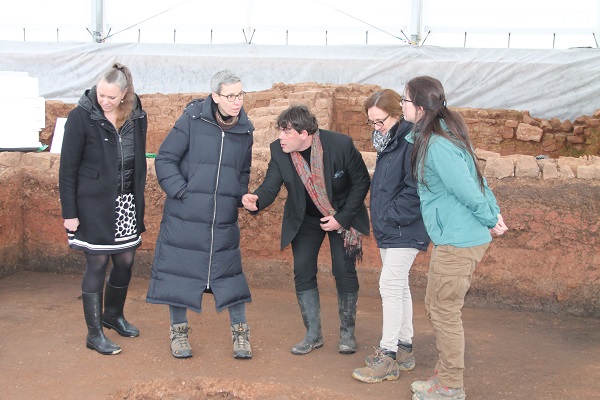 L-R: Environment Minister Carole Dieschbourg; Culture Minister Sam Tanson; CNRA Director Foni Le Brun-Ricalens; Sabine Groetembril, archaeologist at CEPMR;
Credit: MCULT
L-R: Environment Minister Carole Dieschbourg; Culture Minister Sam Tanson; CNRA Director Foni Le Brun-Ricalens; Sabine Groetembril, archaeologist at CEPMR;
Credit: MCULT
On Friday 28 February 2020, stakeholders discussed future ways to enhance the role of the Gallo-Roman villa "Auf Schlammgraecht", located in Shieren in central Luxembourg, as a national and European ancient site and to facilitate public accessibility.
In the presence of the College of Aldermen of the municipality of Schieren, the newly appointed Mayor of Shieren, Eric Thill, and the Director of the National Archaeological Research Centre (Centre national de recherche archéologique, CNRA), Foni Le Brun-Ricalens, accompanied by Luxembourg's Minister of Culture, Sam Tanson, and Minister for the Environment, Climate and Sustainable Development, Carole Dieschbourg, visited the site of archaeological excavations that are currently taking place on the site of the villa.
Following explanations provided by CNRA representatives, stakeholders discussed future ways to improve the villa as an outstanding national and European archeological site and to facilitate its access to the public.
Due to its exceptional conservation status, the villa has significant scientific interest. The estate consists of the main palace (pars urbana), spas and a dozen outbuildings (pars rustica), covering more than eight hectares.
During the visit, Culture Minister Sam Tanson commented: "The fact that such treasures are hidden beneath our feet demonstrates the need for the proper legal framework for preventative archeology". Minister Tanson was referring to the Cultural Heritage Act, introduced in August 2019 in the Luxembourg Parliament.
The scientific work on this site was carried out in an initial phase from 2013 to 2018, as part of the widening of the B7 road to improve the accessibility of the site. This project was co-funded by the Ministry of Culture and the Ministry of Mobility and Public Works. In a second phase from 2019 to 2023, excavations will focus on the main building, which is spread over 4,000m2.
During the visit, the Director and representatives of the CNRA presented the site and the main building of the villa being excavated. The exceptional character of this Roman villa, with its excellent state of preservation, has been repeatedly emphasised and illustrated with examples such as the imprint on the floor of the palace which is preserved in its entirety and not replaced by later constructions.
Archaeologist-tachographologist Sabine Groetembril of the Centre for the Study of Roman Murals (Centre d'étude des peintures murales romaines de Soissons, CEPMR) in Soissons (France) provided additional explanations on the wall paintings and their restoration. Since 2015, polychrome frescoes have been updated annually as the excavation progresses. The paintings are animated by various mythological representations.








